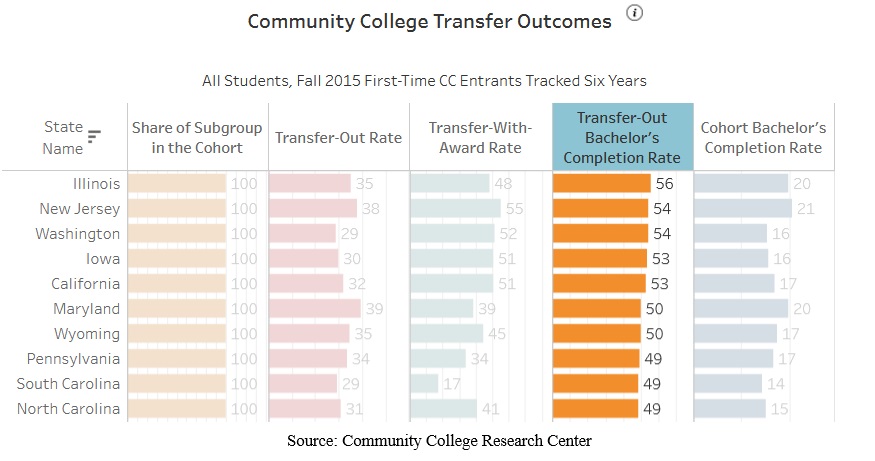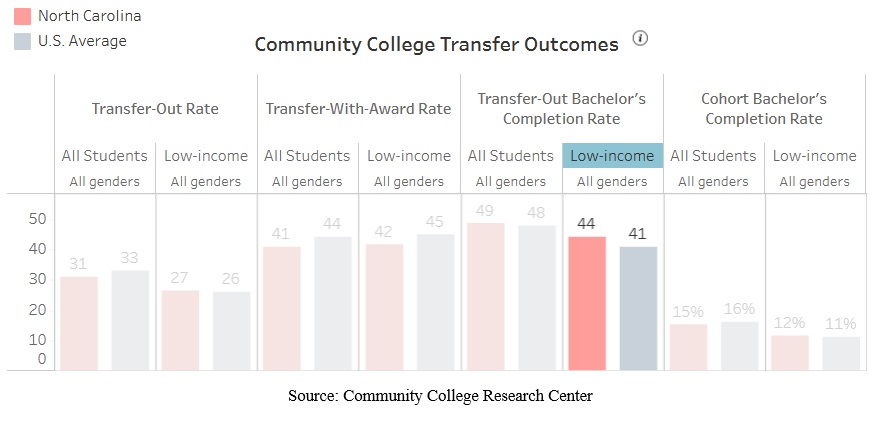Significant student-loan debt has hindered young people. That much is clear. Politicians, commentators, and vocal citizens often throw their two cents in on whether it is the individual’s or society’s responsibility to pay such loans back. Yet young people have to work within the system that exists right now, not the theoretical one that may never arrive. Many are turning to the community-college system in order to obtain a degree at a fraction of the cost. Those at the top should certainly try to sort out the mess that has been created by the federal government’s student-loan programs. But students must remember that they still have some agency.
North Carolina’s community colleges are now tenth in the nation in transfer-out bachelor’s completion rate, a marked improvement.Of course, this raises the question of how many community-college students successfully navigate the process of transferring schools and obtaining a full bachelor’s degree. New data suggest that the answer may be “not many” but that the situation is improving, at least for North Carolina. The figures in question look at community-college transfer outcomes across states for the 2015 student cohort. These numbers indicate that North Carolina has fared fairly well, especially when compared to other states.
Specifically, North Carolina’s community colleges are now 10th in the nation in transfer-out bachelor’s completion rate, as the chart below indicates.

Additionally, as EdNC previously reported, North Carolina had the largest increase in transfer-out rate of any state. That figure increased from 24 percent to 31 percent from fall 2007 to fall 2015.
Less-advantaged students did well in North Carolina, too. As the next chart reveals, 44 percent of low-income transfer-out students received a bachelor’s degree in six years. The national average was only 41 percent.

How did North Carolina do it? The most likely theory has to do with the success of the most recent North Carolina Comprehensive Articulation Agreements (CAA).
The CAA are statewide agreements that govern the transfer of credits between the state’s community colleges and its public universities, with the objective of smoothing the process for students. The first CAA was issued in 2010. It was then updated in 2014 and again in 2016. The CAA is an agreement for the entire UNC System and applies to 58 community colleges and 16 university campuses. Rather than having students figure out the minutiae of transferring credits for themselves, the CAA simplifies the process.
The 2014 revised CAA had four components that directly impacted the 2015 cohort (the cohort observed in the data set mentioned above). These included:
1. agreed-upon guaranteed transfer of certain general education courses from any NCCCS institution to any UNC System institution;
2. a requirement of all UNC System institutions to publish four-year degree plans with courses mapped to course offerings at NCCCS institutions;
3. a suggestion that all NCCCS students intending to transfer declare their planned transfer major prior to completing 30 hours of coursework; and
4. guaranteed 60 transferable credit hours to a UNC System institution for all NCCCS students who complete a transfer associate’s degree, Associate in Arts or Associate in Sciences.
A quick Google search shows the CAA’s effectiveness, particularly where the course-mapping requirement is concerned. Browsing online, one is able to find the bachelor’s degree one wants to attain and which courses to take at an N.C. community college. One can also see which subsequent courses to take at the desired four-year institution. The guaranteed transfer of certain courses allows students to cost-effectively complete their general-education requirements without worrying about whether they will find out their time was wasted down the line.
A key component that the 2014 CAA specifically mentions and that is necessary for this cohesive college-credit system to be effective is that students must have a game plan from the start. Many students begin their college careers aimlessly, assuming that college is itself the best possible path but without any real idea of their lives post-degree. But no matter what the higher ups decide or plan, the truth is that students have most of their fate in their own hands. The CAA cannot force a student to be successful. Students cause their own success.
The guaranteed transfer of certain courses allows students to cost-effectively complete their general-education requirements.Students need to be made aware of the importance of their choices during, and coming out of, high school. Eighteen-year-olds should not be told that college is simply for partying or that taking out thousands in student-loan debt without a plan is a good idea. In fact, it might be better for a student to take a gap year and begin school a year later than to bounce from major to major and course to course without a real plan.
Students should begin with the end in mind: If one wants to save money and spend the first two years of one’s education in community college, then one should do so by first deciding which bachelor’s degree one eventually wants to obtain and which school one wants to be listed on that degree. Then, after visiting that school’s website and downloading the course mapping for that degree, one should be able to obtain an associate’s degree in confidence that all one’s courses will “count.”
The data on the 2015 cohort are heartening, and the tide seems to be changing. Generation Z should follow in the footsteps of the improved 2015 cohort: Use the CAA to your advantage, and carefully consider all of your options before signing on the dotted line of student-loan debt. A couple of years at a community college is a small price that could potentially pay big dividends later. As we all find out eventually, the decisions one makes at 18 have the potential to greatly improve, or worsen, one’s life for decades to come. Thanks in part to an effective CAA, North Carolina students have the power to make their choices count.
Grace Hall is a communications assistant at the James G. Martin Center for Academic Renewal. She works and lives in Georgia.

